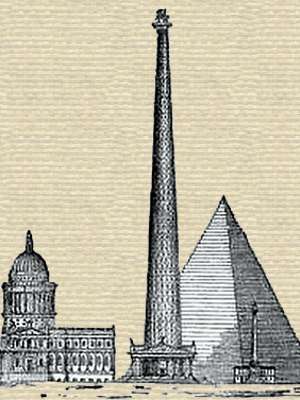 (source)
(source)
|
Richard Trevithick
(13 Apr 1771 - 22 Apr 1833)
English mechanical engineer and inventor who successfully harnessed high-pressure steam and constructed the world's first steam railway locomotive (1803).
|
THE FIRST PROJECT FOR A
ONE THOUSAND FOOT TOWER.
from Scientific American Supplement (1887)
At the time of the Philadelphia Exhibition, the Americans conceived the idea of constructing a tower a thousand feet in height, but the project was never carried out. In 1832 the Vote on the reform bill suggested to [Richard] Trevithick the idea of perpetuating the memory of the event by the erection of a column higher than any that had ever up till then been constructed. The celebrated English engineer drew up the following note, which was inserted in the Morning Herald of July 11, 1883:
National Monument in Honor of Reform.—The great measure of reform, which has become the law of the country, should be recalled through the construction of an extraordinary monument exceeding in height Cleopatra’s Needle and Pompey’s Column, and symbolizing the beauty, strength, and unalterable grandeur of the British Constitution. With this end in view, it is proposed to hold a meeting for which a special call will be made, and there will be opened throughout the entire kingdom a subscription to which will be admitted even the smallest sums, with a maximum of two guineas.
This note was followed by the names of eminent persons who had given their approbation. The description of the monument was thus given:
“We give a sketch of the 1,000 foot openwork cast iron column, 100 feet in diameter at the base and 12 feet at the apex, consisting of fifteen hundred 11 x 11 foot plates, containing a circular depression in the center 6 feet in diameter, and, near each angle, an aperture 1½ feet in diameter, the object of such openings being to reduce the weight and to diminish the effect of the wind.
“These plates will be 2 inches in thickness, and will have flanges on the sides so as to permit of their being united by bolts, with the interposition of strips of lead. This column will rest upon a circular foundation, with a base 60 feet in height. It will have a cap with a platform 49 feet in diameter, and will carry a statue 39 feet in height. In the center of the column there will be a cylindrical tube 10 feet in diameter, for the reception of an elevator.
“Each plate will weigh about three tons, so that the total weight may be estimated at 6,000 tons. A 20 horse power steam engine will be sufficient to elevate one plate to the entire height in ten minutes, and, as it will be possible to employ a large number of workmen at the same time in assembling the plates, one plate per hour may be easily put in place. The 1,500 plates, then, may be assembled in a little less than six months. Certain foundrymen have engaged to deliver these pieces on the spot at $35 per ton. At such a price the construction of this national monument would not cost over $400,000.
“As stated, there will be a tube 10 feet in diameter, in which will move an iron plate piston provided with seats for twenty-five persons. This piston will be raised by compressed air, through a pump actuated by a steam engine, with an ascensional velocity of about 3 feet per second, so that the entire ascent will require about five minutes. At the base of the tube there will be a door opening outwardly and inwardly to allow persons to enter who desire to ascend. When once this door is opened, the pressure of the air will keep it so. The piston will be provided with an aperture and a cock, serving to regulate the descent by allowing the air to escape.
“The aperture will be such that the descending velocity shall not exceed 10 feet per second. Under such circumstances, there will be no greater shock upon reaching the bottom than that which would be experienced by an object falling from a height of 8½ inches, or than that which would be experienced by a person walking at the rate of 118 feet per hour and suddenly stopped. At London, the 213 foot column called the Monument is much admired. People ascend 419 feet to reach the cross of St. Paul’s Cathedral, and daring tourists make an immense climb to scale the 490 feet of the pyramids of Egypt.
“How much more agreeable would it be to ascend a thousand feet on a cushion of compressed air, to contemplate London at one’s feet, and to descend again to the ordinary level of daily life, gently and without shock, at a moderate velocity regulated by the simple opening of a cock, without anything being able to accelerate such velocity beyond 3 feet per second, and allowing the traveler to be set down at the end of the trip without receiving any greater shaking up than he would if he were descending a stairway?”
A few meetings were held, and the project in a few months was sufficiently advanced to make it possible to present the plans to the King of England, William IV., on March 1, 1833. But Trevithick died on the 22d of April, and the 1,000 foot column was forgotten. It is of interest from a historical standpoint to recall the matter.
The Bulletin of the Society of Civil Engineers, from which we borrow these data, adds: “Far from depreciating the merit of our colleague, Mr. [Gustave] Eiffel, our object has been to show, through the distance that separates the latter’s well elaborated project from Trevithick’s sketch, the immense progress that has been made during the last half century in the use of metals in constructions.”
For our part, we shall add that Mr. Eiffel’s monument appears to us to be one of the most important projects of our epoch.—La Nature.
- Science Quotes by Richard Trevithick.
- 13 Apr - short biography, births, deaths and events on date of Trevithick's birth.
- Richard Trevithick - Biography from Memoirs of the Distinguished Men Of Science (1862).
- Richard Trevithick: Giant of Steam, by Anthony Burton. - book suggestion.






